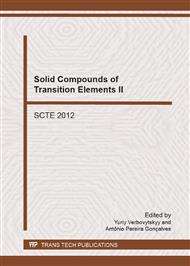p.45
p.50
p.54
p.58
p.62
p.67
p.71
p.75
p.80
Numerical Analysis of Time Dependent Effects in Bulk Nanocrystalline Hard Magnets
Abstract:
The presented work concerns numerical analysis of t-dependent magnetization curves. We propose the approach consisting in application of the so-called simulated annealing algorithm (SA) supplemented with local maximum entropy condition. Efficiency of the SA procedure and its parameters was tested with the use of computer generated curves derived from known distributions of relaxation time τ. Based on the determined SA parameters the analysis of empirical M(t) dependences measured for (Fe80Nb6B14)1-xTbx (x=0.08, 0.16) bulk nanocrystalline alloys were also carried out. As it was shown the SA procedure allows determining distributions of relaxation time without preliminary assumption about its shape and number of components.
Info:
Periodical:
Pages:
62-66
Citation:
Online since:
November 2012
Price:
Сopyright:
© 2013 Trans Tech Publications Ltd. All Rights Reserved
Share:
Citation:


